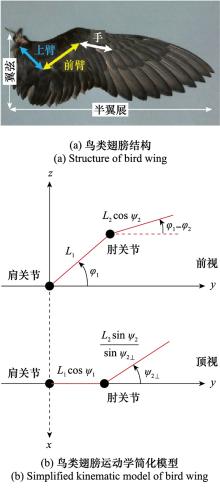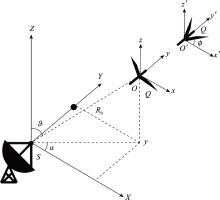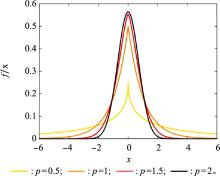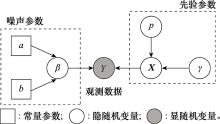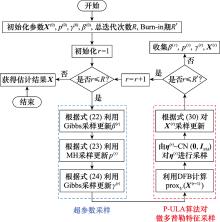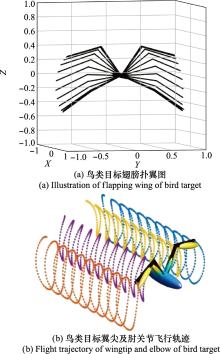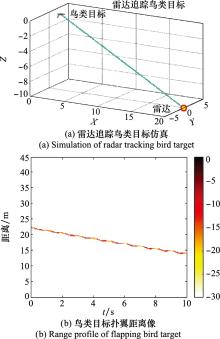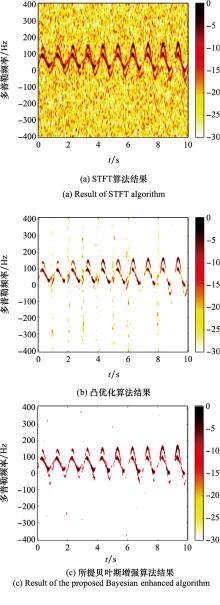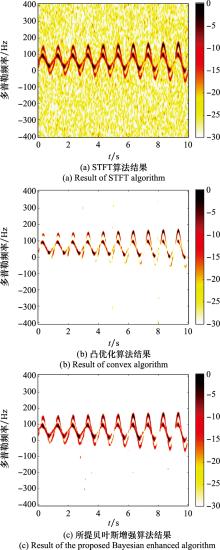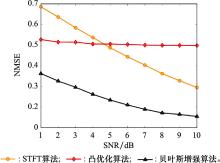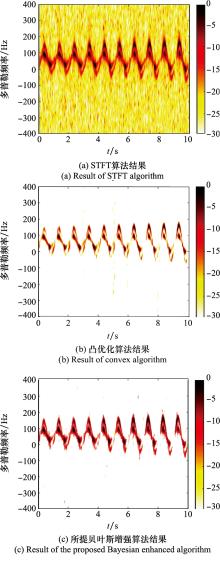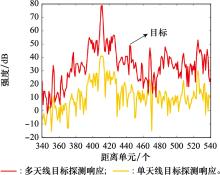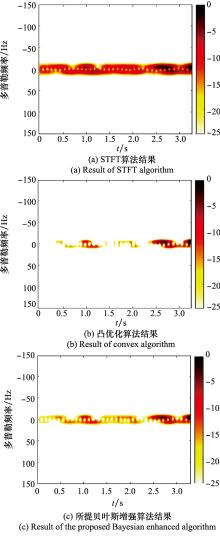Systems Engineering and Electronics ›› 2024, Vol. 46 ›› Issue (2): 505-516.doi: 10.12305/j.issn.1001-506X.2024.02.15
• Sensors and Signal Processing • Previous Articles
Bayesian enhancement algorithm for micro-Doppler feature of radar bird target
Lei YANG1,*, Weitian SUN1, Xinyao MAO2, Yabo XIA1, Jinghe SANG1
- 1. College of Electronic Information and Automation, Civil Aviation University of China, Tianjin 300300, China
2. Tianjin Port Yuanhang International Ore Terminal Co., Ltd., Tianjin 300452, China
-
Received:2022-09-23Online:2024-01-25Published:2024-02-06 -
Contact:Lei YANG
CLC Number:
Cite this article
Lei YANG, Weitian SUN, Xinyao MAO, Yabo XIA, Jinghe SANG. Bayesian enhancement algorithm for micro-Doppler feature of radar bird target[J]. Systems Engineering and Electronics, 2024, 46(2): 505-516.
share this article
| 1 |
PHILLIPS A C , MAJUMDAR S , WASHBURN B E , et al. Efficacy of avian radar systems for tracking birds on the airfield of a large international airport[J]. Wildlife Society Bulletin, 2018, 42 (3): 467- 477.
doi: 10.1002/wsb.910 |
| 2 |
HU C Y , WANG L , LI Z , et al. Inverse synthetic aperture radar imaging using a fully convolutional neural network[J]. IEEE Trans.on Geoscience and Remote Sensing Letters, 2020, 17 (7): 1203- 1207.
doi: 10.1109/LGRS.2019.2943069 |
| 3 | 陈唯实, 黄毅峰, 陈小龙, 等. 机场探鸟雷达技术发展与应用综述[J]. 航空学报, 2021, 43 (1): 176- 196. |
| CHEN W S , HUANG Y F , CHEN X L , et al. Developments and applications of airport avian radar: review[J]. Acta Aeronautica et Astronautica Sinica, 2021, 43 (1): 176- 196. | |
| 4 |
RAHMAN S , ROBERTSON D A . Radar micro-Doppler signatures of drones and birds at K-band and W-band[J]. Scientific Reports, 2018, 8 (1): 17396.
doi: 10.1038/s41598-018-35880-9 |
| 5 | 陈小龙, 南钊, 张海, 等. 飞鸟与旋翼无人机雷达微多普勒测量实验研究[J]. 电波科学学报, 2021, 36 (5): 704- 714. |
| CHEN X L , NAN Z , ZHANG H , et al. Experimental research on radar micro-Doppler of flying bird and rotor UAV[J]. Chinese Journal of Radio Science, 2021, 36 (5): 704- 714. | |
| 6 | ALVAREZ R, BORBOR E, GRIJALVA F. Comparison of methods for signal analysis in the time-frequency domain[C]//Proc. of the IEEE 4th Ecuador Technical Chapters Meeting, 2019. DOI: 10.1109/ETCM48019.2019.9014860. |
| 7 |
DONOHO D L . Compressed sensing[J]. IEEE Trans.on Information Theory, 2006, 52 (4): 1289- 1306.
doi: 10.1109/TIT.2006.871582 |
| 8 |
ZHAO L , WANG L , YANG L , et al. The race to improve radar imagery: an overview of recent progress in statistical sparsity-based techniques[J]. IEEE Trans.on Signal Processing Magazine, 2016, 33 (6): 85- 102.
doi: 10.1109/MSP.2016.2573847 |
| 9 |
YANG L , LI P C , ZHANG S , et al. Cooperative multitask learning for sparsity-driven SAR imagery and nonsystematic error autocalibration[J]. IEEE Trans.on Geoscience and Remote Sensing, 2020, 58 (7): 5132- 5147.
doi: 10.1109/TGRS.2020.2972972 |
| 10 |
MALLAT S G , ZHANG Z . Matching pursuits with time-frequency dictionaries[J]. IEEE Trans.on Signal Processing, 1993, 41 (12): 3397- 3415.
doi: 10.1109/78.258082 |
| 11 |
DONOHO D L , TSAIG Y , DRORI I , et al. Sparse solution of underdetermined systems of linear equations by stagewise orthogonal matching pursuit[J]. IEEE Trans.on Information Theory, 2012, 58 (2): 1094- 1121.
doi: 10.1109/TIT.2011.2173241 |
| 12 |
SELESNICK I . Sparse regularization via convex analysis[J]. IEEE Trans.on Signal Processing, 2017, 65 (17): 4481- 4494.
doi: 10.1109/TSP.2017.2711501 |
| 13 | 杨磊, 李慧娟, 黄博, 等. 双层稀疏组Lasso高分辨SAR结构特征增强成像[J]. 系统工程与电子技术, 2021, 43 (2): 351- 362. |
| YANG L , LI H J , HUANG B , et al. High resolution SAR imagery with structural feature enhancement under two-layer sparse group Lasso[J]. Systems Engineering and Electronics, 2021, 43 (2): 351- 362. | |
| 14 | 杨磊, 李埔丞, 李慧娟, 等. 稳健高效通用SAR图像稀疏特征增强算法[J]. 电子与信息学报, 2019, 41 (12): 2826- 2835. |
| YANG L , LI P C , LI H J , et al. Robust and efficient sparse-feature enhancement for generalized SAR imagery[J]. Journal of Electronics and Information Technology, 2019, 41 (12): 2826- 2835. | |
| 15 |
WANG L , ZHAO L F , BI G A , et al. Enhanced ISAR imaging by exploiting the continuity of the target scene[J]. IEEE Trans.on Geoscience and Remote Sensing, 2014, 52 (9): 5736- 5750.
doi: 10.1109/TGRS.2013.2292074 |
| 16 |
ZHAO L F , WANG L , BI G A , et al. An autofocus technique for high-resolution inverse synthetic aperture radar imagery[J]. IEEE Trans.on Geoscience and Remote Sensing, 2014, 52 (10): 6392- 6403.
doi: 10.1109/TGRS.2013.2296497 |
| 17 |
YANG L , ZHAO L F , BI G A , et al. SAR ground moving target imaging algorithm based on parametric and dynamic sparse Bayesian learning[J]. IEEE Trans.on Geoscience and Remote Sensing, 2016, 54 (4): 2254- 2267.
doi: 10.1109/TGRS.2015.2498158 |
| 18 | 沈笑云, 廖仙华, 孙卫天, 等. 可变先验贝叶斯学习稀疏SAR成像[J]. 系统工程与电子技术, 2021, 43 (7): 1781- 1790. |
| SHEN X Y , LIAO X H , SUN W T , et al. Sparse SAR imaging based on varying prior Bayes learning[J]. Systems Engineering and Electronics, 2021, 43 (7): 1781- 1790. | |
| 19 | CHEN V C . The micro-Doppler effect in radar[M]. 2nd ed Boston: Artech House, 2019. |
| 20 | HERR D B, TAHMOUSH D. Data-driven STFT for UAV micro-Doppler signature analysis[C]//Proc. of the IEEE International Radar Conference, 2020. DOI: 10.1109/RADAR42522.2020.9114726. |
| 21 |
ZHAO N , BASARAB A , KOUAME D , et al. Joint segmentation and deconvolution of ultrasound images using a hierarchical Bayesian model based on generalized Gaussian priors[J]. IEEE Trans.on Image Processing, 2016, 25 (8): 3736- 3750.
doi: 10.1109/TIP.2016.2567074 |
| 22 |
KARAKUS O , KURUOGLU E E , ACHIM A . A generalized Gaussian extension to the Rician distribution for SAR image modeling[J]. IEEE Trans.on Geoscience and Remote Sensing, 2022, 60 (1)
doi: 10.1109/TGRS.2021.3069091 |
| 23 | RAHIMI A , SAPP J , XU J , et al. Examining the impact of prior models in transmural electrophysiological imaging: a hie-rarchical multiple-model Bayesian approach[J]. IEEE Trans.on Medical Imaging, 2015, 35 (1): 229- 243. |
| 24 | ANDRIEU C , FREITAS N D , DOUCET A , et al. An introduction to MCMC for machine learning[J]. Machine Learning, 2003, 50 (1): 5- 43. |
| 25 | SMIDL V , QUINN A . The variational Bayes method in signal processing[M]. New York: Springer, 2006. |
| 26 |
TZIKAS D G , LIKAS A C , GALATSANOS N P . The variational approximation for Bayesian inference[J]. IEEE Trans.on Signal Processing Magazine, 2008, 25 (6): 131- 146.
doi: 10.1109/MSP.2008.929620 |
| 27 | 杨磊, 毛欣瑶, 杨晓炜, 等. 基于非监督贝叶斯学习雷达性能指标动态评估[J]. 系统工程与电子技术, 2021, 43 (1): 74- 82. |
| YANG L , MAO X Y , YANG X W , et al. Dynamic evaluation of radar performance index based on unsupervised Bayesian learning[J]. Systems Engineering and Electronics, 2021, 43 (1): 74- 82. | |
| 28 | COFFEY W T , KALMYKOV Y P . The Langevin equation: with application to stochastic problems in physics, chemistry and electrical engineering[M]. 4th ed Singapore: World Scientific, 2017. |
| 29 |
PEREYRA M . Proximal Markov chain Monte Carlo algorithms[J]. Statistics and Computing, 2016, 26 (4): 745- 760.
doi: 10.1007/s11222-015-9567-4 |
| 30 |
CORBINEAU M C , KOUAME D , CHOUZENOUX E , et al. Preconditioned P-ULA for joint deconvolution-segmentation of ultrasound images[J]. IEEE Trans.on Signal Processing Letters, 2019, 26 (10): 1456- 1460.
doi: 10.1109/LSP.2019.2935610 |
| 31 |
COMBETTES P L , DUNG D , VU B C . Proximity for sums of composite functions[J]. Journal of Mathematical Analysis and Applications, 2011, 380 (2): 680- 688.
doi: 10.1016/j.jmaa.2011.02.079 |
| [1] | Lei YANG, Yabo XIA, Xianhua LIAO, Xinyao MAO, Yuchen DOU, Huan YANG. Super-resolution ISAR imagery algorithm based on bi-sparsity Bayesian learning [J]. Systems Engineering and Electronics, 2023, 45(5): 1371-1379. |
| [2] | Zhongyue LI, Tong WANG. Sparse Bayesian learning-based robust STAP algorithm [J]. Systems Engineering and Electronics, 2023, 45(10): 3032-3040. |
| [3] | Anlin XU, Yu ZHANG, Feng ZHOU. High resolution ISAR imaging based on Beta process [J]. Systems Engineering and Electronics, 2022, 44(6): 1873-1879. |
| [4] | Qinzhe LYU, Yinghui QUAN, Minghui SHA, Shuxian DONG, Mengdao XING. Ensemble deep learning-based intelligent classification of active jamming [J]. Systems Engineering and Electronics, 2022, 44(12): 3595-3602. |
| [5] | Jun ZHANG, Xinyu ZHANG, Weidong JIANG, Yongxiang LIU, Xiang LI. Fast DOA estimation method using generalized approximate message passing [J]. Systems Engineering and Electronics, 2022, 44(10): 2995-3002. |
| [6] | Dongxia LI, Qiuyu CHEN, Lei WANG, Haitao LIU. DME pulse interference suppression method based on BSBL-BO algorithm [J]. Systems Engineering and Electronics, 2021, 43(9): 2649-2656. |
| [7] | Xiaoyun SHEN, Xianhua LIAO, Weitian SUN, Yabo XIA, Lei YANG. Sparse SAR imaging based on varying prior Bayes learning [J]. Systems Engineering and Electronics, 2021, 43(7): 1781-1790. |
| [8] | Lei YANG, Xinyao MAO, Xiaowei YANG, Hai ZHANG, Fei YANG, Lin SUN. Dynamic evaluation of radar performance index based on unsupervised Bayesian learning [J]. Systems Engineering and Electronics, 2021, 43(1): 74-82. |
| [9] | Jingjing SI, Yanan HAN, Lei ZHANG, Yinbo CHENG. 1-Bit compressive sensing based on generalized pattern-coupled sparse Bayesian learning [J]. Systems Engineering and Electronics, 2020, 42(12): 2700-2707. |
| [10] | YUAN Jun, XIAO Hui, CAI Zhiming, XI Chang. Spatial spectrum estimation based on sparse Bayesian learning for towed linear array [J]. Systems Engineering and Electronics, 2019, 41(6): 1202-1209. |
| [11] | ZHANG Yongshun, ZHU Weigang, JIA Xin, WANG Manxi. NBI detection and parameter estimation in DSSS communications based on BSBL [J]. Systems Engineering and Electronics, 2019, 41(4): 889-897. |
| [12] | FENG Mingyue, HE Minghao, YU Chunlai, QU Zhiguo. 2D-DOA estimation with high accuracy using double parallel co-prime array [J]. Systems Engineering and Electronics, 2017, 39(5): 977-983. |
| [13] | ZHOU Xiao-meng, HOU Chao-huan, YAN Jin, CHEN Peng. Approach to signal detection in doubly-spread channels based on STFT [J]. Journal of Systems Engineering and Electronics, 2009, 31(10): 2506-2509. |
| Viewed | ||||||
|
Full text |
|
|||||
|
Abstract |
|
|||||
